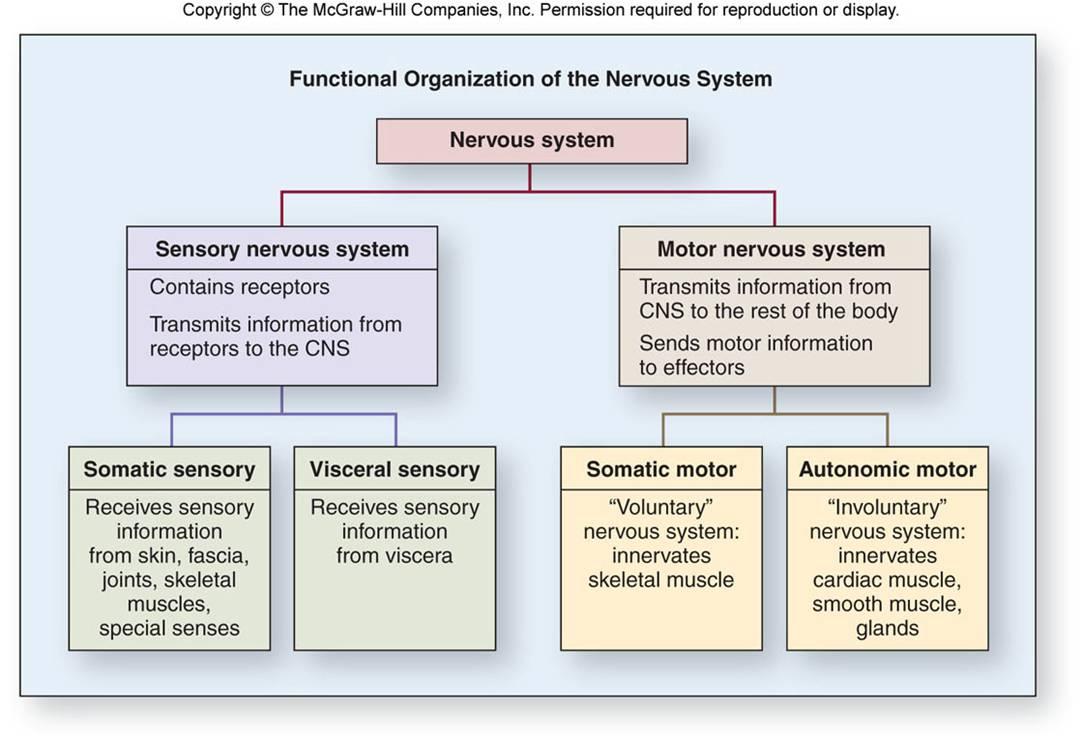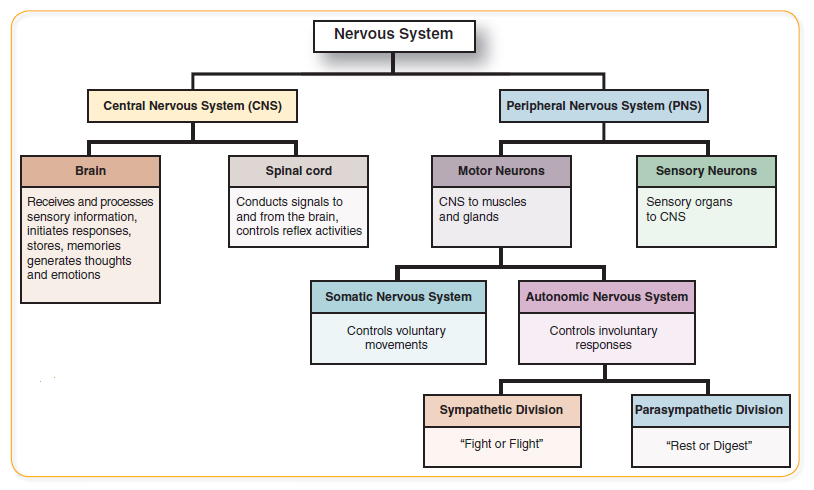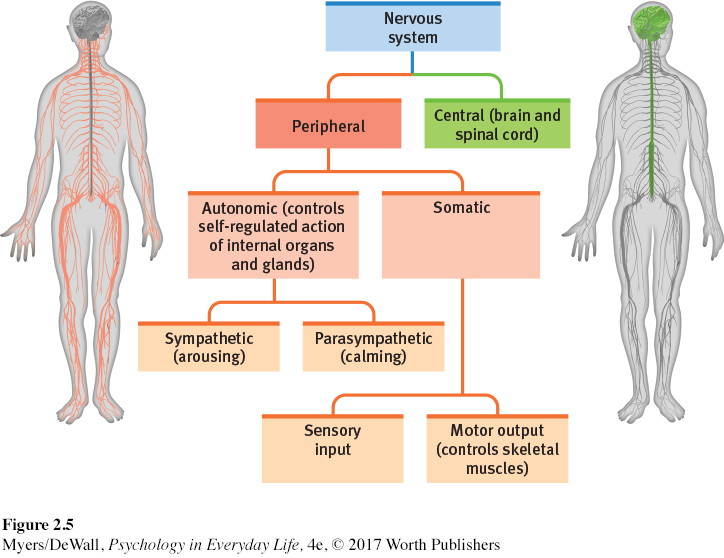Explain the Different Nervous System Divisions and Functions
The somatic division of the nervous system contains nerves which end in the skeletal muscles. The central nervous system is made up of the brain the spinal cord and the retina and controls essentially all the functions that keep you alive and allow you to experience life.
Divisions Of The Nervous System
Central Nervous System CNS and Peripheral Nervous System PNS.
. 4 Explain the difference between white and gray matter. The motor also known as efferent division of the nervous system contains motor nerves. The nervous system performs three functions.
The nervous system transmits signals between the brain and the rest of the body including internal organs. The somatic nervous system causes contraction of. 5 Describe how action potentials are transmitted through the nervous system.
It prepares the body for. The CNS and the PNS both contribute to the same functions but those functions can be attributed to different regions of the brain such as the cerebral cortex or the hypothalamus or to different ganglia in the periphery. 2 Describe the relationships between the different divisions of the nervous system.
Here is a diagram that you can refer to while you read about the human nervous system function and parts. The afferent or sensory division transmits impulses from peripheral organs to the CNS. Sensation - it analyses sensory information from the external environment or the body itself.
The nervous system is mainly divided into central nervous system peripheral nervous system and autonomic nervous system. The nervous system maintains body homeostasis with electrical signals. And activates muscles and glands 1.
Central Nervous System CNS is often called the central processing unit of the body. Effects or causes a response. The peripheral nervous system is made up of nerves that branch off from the spinal cord and extend to all parts of the body.
The central nervous system CNS and the peripheral nervous system PNS. Explain how the functions of sympathetic and parasympathetic divisions of the peripheral nervous system are different. The nervous system can be divided into two functional parts.
Human nervous system is mainly divided into 3 divisions which are as follows. There are two major divisions of the nervous system. Explain the basic functions of the nervous system.
Processes and interprets 3. They then exit the spinal nerve through a white ramus communicans myelinated. Peripheral Nervous System 3.
Under stressful circumstances the entire sympathetic nervous system can be activated resulting in an immediate widespread reaction. The central nervous system is made up of the brain and spinal cord. The CNS performs integrative and control functions.
The cell bodies of the preganglionic axons of the sympathetic division are located in segments T1 through L3 of the lateral horn of the spinal cord. They work together to manage how the body responds to our changing environment and needs. 3 weeks later 50 were recaptured 10 of which had markers.
Central Nervous System 2. Provides for sensation higher mental functioning and emotional response. It is divided into two parts Sympathetic Nervous System.
The Central and Peripheral Nervous Systems. But some scientists have classified them into two divisions in which the ANS. The CNS contains the great majority of neuronal cell bodies and is divisible into the spinal cord and the brain.
Sensation integration and response. Peripheral Nervous System includes all the nerves of the body Central Nervous System. The central nervous system CNS consists of the brain and the spinal cord while the peripheral nervous system PNS consists of sensory neurons ganglia clusters of neurons and nerves.
The major differences between the two systems are evident in the responses that each produces. The peripheral nervous system is further subdivided into an afferent sensory division and an efferent division. For convenience the nervous system can be divided into two major divisions.
The sympathetic nervous system which controls how you respond in an emergency it makes your heart beat faster and causes you to release adrenaline and the parasympathetic nervous system which prepares the body for rest. Central nervous system. 110 moose were captured tagged and released.
The nervous system can also be divided on the basis of its functions but anatomical divisions and functional divisions are different. These nerves conduct impulses from the CNS and PNS to the muscles organs and glands effecting what happens in those tissues. 1 sympathetic division activatesspeeds up fight or flight 2 parasympathetic division slows down inhibits processes rest digest.
The autonomic nervous system relays impulses from the central nervous system to the involuntary organs and smooth muscles of the body. Central Nervous System. 3 Identify the cell types and their functions of the nervous systems.
Biology questions and answers. The brain is one of the important largest and central organ of the human nervous system. It consists of the brain and the spinal cord.
Nervous system Functions of the nervous system. The efferent or motor division transmits impulses from the CNS out to the peripheral organs to cause an effect or action. The picture you have in your mind of the nervous system probably includes the brain the nervous tissue contained within the cranium and the spinal cord the extension of nervous tissue within the vertebral columnAdditionally the nervous tissue that reach out from the brain and spinal cord to the rest of the body nerves are also.
Even though the brain and spinal. The nervous system can be functionally divided into 3 actions. 4 rows The nervous system NS is structurally broken down into two divisions.
A study was conducted on moose in a local region. The sympathetic nervous system is a division of the nervous system that is responsible for forming localised adjustments such as sweating in response to a rise in temperature and reflexing cardiovascular system adjustments. The nervous system is involved in receiving information about the environment around us sensation and generating responses to that information motor responses.
The nervous system has two main parts. The somatic nervous system and the autonomic nervous system. The sympathetic nervous system consists of nerves arising from the spinal cord between the neck and waist region.
From here these axons project away from the spinal cord through the ventral root and enter a spinal nerve. There are 2 parts to the autonomic nervous system.

What Are The Functional Divisions Of The Nervous System Socratic

What Is The Function Of The Sensory Division Of The Peripheral Nervous System Socratic

No comments for "Explain the Different Nervous System Divisions and Functions"
Post a Comment